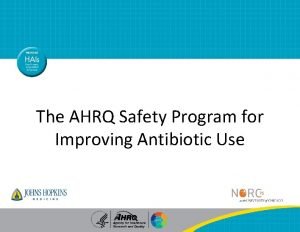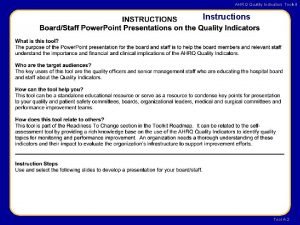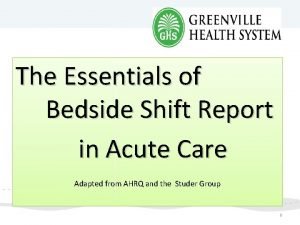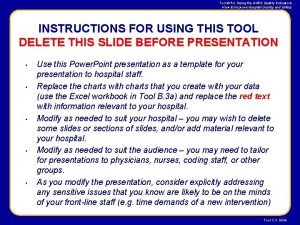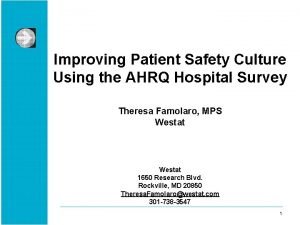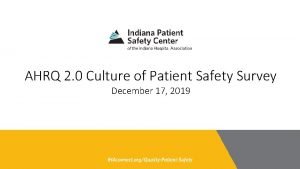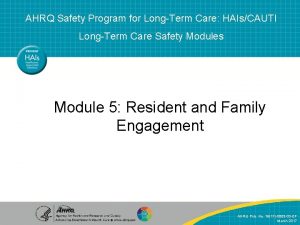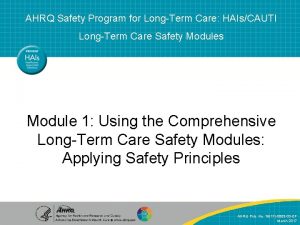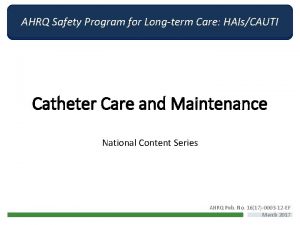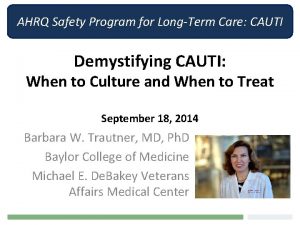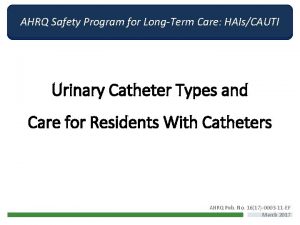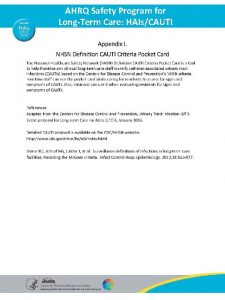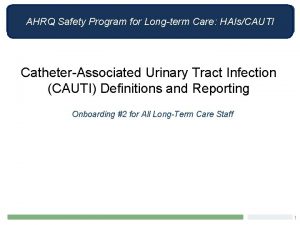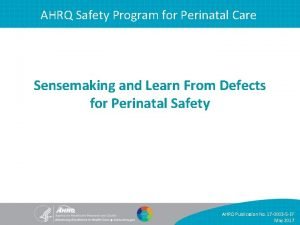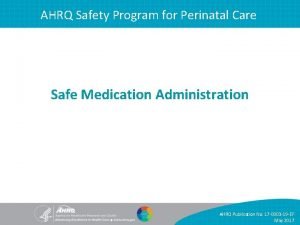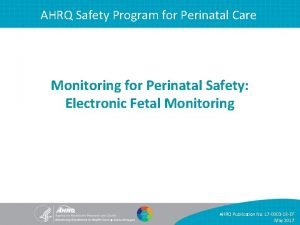AHRQSafety Program for LongTerm Longterm Care AHRQ Care














- Slides: 14

AHRQSafety. Program for Long-Term Long-term Care: AHRQ Care: HAIs/CAUTI The How-To’s of Hand Hygiene Training Module 1 AHRQ SAFETY PROGRAM FOR LONG-TERM CARE: HAIs/CAUTI AHRQ Pub. No. 16(17)-0003 -8 -EF March 2017

Objectives Upon completion of this training module, long-term care staff will be able to demonstrate a working knowledge of— • Why hand hygiene is so important to prevent the spread of infections • When and how to perform hand hygiene • Key hand hygiene practices for prevention of health care-associated infections (HAI), particularly catheter-associated urinary tract infections (CAUTI) AHRQ SAFETY PROGRAM FOR LONG-TERM CARE: HAIs/CAUTI Hand Hygiene │ 2

Health Care Workers’ Hands Spread Infections 1 • 1 -3 million serious infections estimated to occur every year in U. S. nursing homes • Hand hygiene is one of most important ways to prevent the spread of infections Health Care Workers’ Hand Colonization Following Routine Resident Care 70 Percent colonization 60 50 40 30 20 10 0 Gram-negative bacilli Candida sp AHRQ SAFETY PROGRAM FOR LONG-TERM CARE: HAIs/CAUTI Staph. aureus Vancomycin-resistant enterococci Hand Hygiene │ 3

Simplifying the Moments for Hand Hygiene 2 -3 Source: Public Health Ontario AHRQ SAFETY PROGRAM FOR LONG-TERM CARE: HAIs/CAUTI Hand Hygiene │ 4

Alcohol-Based Hand Rub (ABHR)4, 5 Hand Hygiene Technique 1. Apply hand rub to palm of hand 2. Rub hands together, covering all surfaces 3. Focus on thumbs, tips of fingers, and under fingernails 4. Hands are clean when dry • Usually takes about 15 -20 seconds; follow manufacturer’s guidance Source: World Health Organization AHRQ SAFETY PROGRAM FOR LONG-TERM CARE: HAIs/CAUTI Hand Hygiene │ 5

Soap and Water Hand Washing 4, 6, 7 Hand Hygiene Technique 1. Wet hands with water 2. Apply soap to palm of hand 3. Rub hands together, covering all surfaces for at least 15 seconds 4. Rinse hands with water 5. Dry hands with paper towel and use towel to turn off faucet • Paper towel prevents hands from being recontaminated by faucet handles Source: World Health Organization AHRQ SAFETY PROGRAM FOR LONG-TERM CARE: HAIs/CAUTI Hand Hygiene │ 6

Notes About Hand Hygiene Products 4, 7 • ABHRs/gels are preferred for hand hygiene when hands are not visibly soiled or dirty • Times when hands should be washed with soap (nonantimicrobial or antimicrobial) and water: o When hands are visibly dirty, contaminated, or soiled o After care of residents with infectious diarrhea AHRQ SAFETY PROGRAM FOR LONG-TERM CARE: HAIs/CAUTI Hand Hygiene │ 7

Efficacy of Hand Hygiene Preparations in Killing Bacteria 7 Good Plain soap Better Antimicrobial soap AHRQ SAFETY PROGRAM FOR LONG-TERM CARE: HAIs/CAUTI Best Alcohol-based hand rub Hand Hygiene │ 8

Hand Hygiene and Clostridium difficile (C. diff)7 -9 • Hand hygiene with soap and water is superior at removing the spore form of C. diff • ABHR is more effective for hand disinfection with other organisms • No studies linking ABHR use with an increase in C. diff infection • Encourage soap and water after care of residents with acute diarrhea and use of gowns/gloves to prevent spore contamination of hands AHRQ SAFETY PROGRAM FOR LONG-TERM CARE: HAIs/CAUTI Hand Hygiene │ 9

Important Points About Glove Use 7 • Gloves play a key role in preventing hand contamination —but do NOT replace hand hygiene • Change gloves during care when moving from a contaminated body site to a clean body site • Do not wear the same pair of gloves for the care of more than one resident • Remove and discard gloves after use • Do not wash gloves AHRQ SAFETY PROGRAM FOR LONG-TERM CARE: HAIs/CAUTI Hand Hygiene │ 10

Hand Hygiene Before Urinary Catheter Care Perform hand hygiene and wear gloves immediately before— • Placing or removing an indwelling catheter • Accessing the drainage system to empty the drainage bag or collect a urine sample Why? • Interacting with the resident or environment before handling the urinary device may contaminate hands • Reaching for gloves with unclean hands may contaminate the glove box and outside of the gloves • Then, gloves will contaminate the urinary catheter or urine collection system AHRQ SAFETY PROGRAM FOR LONG-TERM CARE: HAIs/CAUTI Hand Hygiene │ 11

Hand Hygiene After Urinary Catheter Care Remove gloves and perform hand hygiene immediately after— • Handling an indwelling catheter • Accessing the drainage system to empty the drainage bag or collect a urine sample Why? • Hand contamination may occur as a result of small undetected holes in gloves • Hand contamination may occur during glove removal • Hand hygiene protects your hands and the environment from being contaminated AHRQ SAFETY PROGRAM FOR LONG-TERM CARE: HAIs/CAUTI Hand Hygiene │ 12

Hand Hygiene Case Scenarios Let’s chat! Review the three hand hygiene case scenarios as a group. As you discuss them, think about the following questions: • Does our facility staff experience similar challenges to performing hand hygiene at the appropriate times? Why or why not? • What could our facility do to reduce barriers to hand hygiene? • How can I help support a culture of safety around improving hand hygiene in our facility? AHRQ SAFETY PROGRAM FOR LONG-TERM CARE: HAIs/CAUTI Hand Hygiene │ 13

References 1. Mody L, Mc. Neil SA, Sun R, et al. Introduction of a waterless alcohol-based hand rub in a long-term-care facility. Infect Control and Hospital Epidemiology. 2003 Mar; 24(3): 165 -71. PMID: 12683506. 2. Guide on hand hygiene in outpatient and home-based care and long-term care facilities: A guide to the application of the WHO multimodal hand hygiene improvement strategy and the “My Five Moments For Hand Hygiene” approach. 2012. World Health Organization. http: //www. who. int/gpsc/5 may/hh_guide. pdf. Accessed on April 14, 2015. 3. Just Clean Your Hands educational resources. Ontario Agency for Health Protection and Promotion. http: //www. publichealthontario. ca/en/Browse. By. Topic/Infectious. Diseases/Just. Clean. Your. Hands/Pages/JCYH-ltch-Education-andtraining. aspx. Accessed on April 14, 2015. 4. Centers for Disease Control and Prevention. Handy Hygiene in Healthcare Settings. http: //www. cdc. gov/handhygiene/providers/. Accessed on August 29, 2016. 5. World Health Organization. WHO Handrub poster. http: //www. who. int/gpsc/5 may/How_To_Hand. Rub_Poster. pdf. Accessed on April 14, 2015. 6. World Health Organization. WHO handwash poster. http: //www. who. int/gpsc/5 may/How_To_Hand. Wash_Poster. pdf. Accessed on April 14, 2015. 7. Boyce JM, Pittet D, Healthcare Infection Control Practices Advisory Committee, et al. Guideline for hand hygiene in health-care settings. Recommendations of the Healthcare Infection Control Practices Advisory Committee and the HICPAC/SHEA/APIC/IDSA Hand Hygiene Task Force. Society for Healthcare Epidemiology of America/Association for Professionals in Infection Control/Infectious Diseases Society of America. MMWR Recomm Rep. 2002 Oct 25; 51(RR-16): 1 -45. PMID: 12418624. 8. Pop-Vicas A, Baier R. Healthcare workers’ hands and Clostridium difficile spores: Making progress? Infection Control and Hospital Epidemiology. 2014 Jan; 35(1): 16– 17. 9. Yokoe DS, Anderson DJ, Berenholtz SM, et al. A compendium of strategies to prevent healthcare-associated infections in acute care hospitals: 2014 updates. Am J Infect Control. 2014 Aug; 42(8): 820 -8. PMID: 25087135. AHRQ SAFETY PROGRAM FOR LONG-TERM CARE: HAIs/CAUTI Hand Hygiene │ 14
 Ahrq safety program for improving antibiotic use
Ahrq safety program for improving antibiotic use Ahrq quality indicators
Ahrq quality indicators Ahrq bedside shift report
Ahrq bedside shift report Ahrq quality indicators toolkit
Ahrq quality indicators toolkit Ahrq qi
Ahrq qi Ahrq safety culture survey
Ahrq safety culture survey Ahrq patient safety survey
Ahrq patient safety survey Lts stable
Lts stable Thomas silverstein
Thomas silverstein Primary secondary tertiary care
Primary secondary tertiary care Kontinuitetshantering
Kontinuitetshantering Typiska drag för en novell
Typiska drag för en novell Tack för att ni lyssnade bild
Tack för att ni lyssnade bild Ekologiskt fotavtryck
Ekologiskt fotavtryck Shingelfrisyren
Shingelfrisyren
